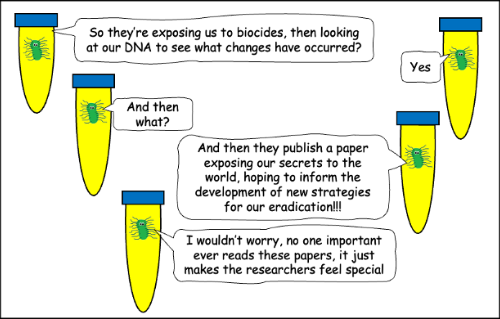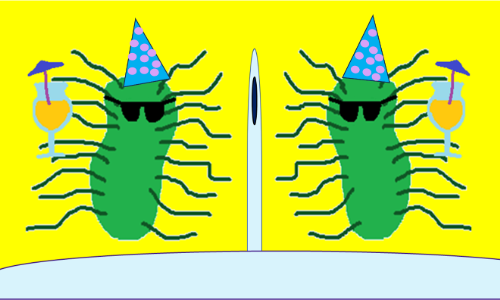Look Mum, I wrote a thing about germs
Posted on October 2, 2025 by Vicky Bennett
Vicky Bennett of Amprologix, UK, takes us behind the scenes of their latest publication 'Prevalence of mutations associated with tolerance to chlorhexidine and other cationic biocides among Proteus mirabilis clinical isolates' published in Microbiology.
Dear Mum,
Recently I helped write a research paper that’s just been published in a scientific journal called Microbiology. It’s open access (free to read), but I’ve never really got the impression you’re a bacteria enthusiast, so some of it may be a bit hard to follow. But don’t worry, this problem is now solved – I’ve written you a bit of an explainer so that you can be as excited about this as me.
This research is something I worked on as part of my PhD at the University of Bath. I’m sure you’re as pleased as I am that I’ve now finished, got a job, and finally moved out of your house. I’m now working at a start-up company called Amprologix, where we’re developing new antibiotics.
For this paper, we investigated something called ‘biocide tolerance’ in a bacteria called Proteus mirabilis. Biocides are chemicals used to kill bacteria, viruses, and other harmful microorganisms (aka germs). You know all those cleaning products you panic bought just before the first COVID lockdown that are now gathering dust under the kitchen sink? On the labels you’ll see chemical names like chlorhexidine and benzalkonium chloride – these are examples of biocides.
Hospitals and healthcare settings also rely on biocides to stop infections from spreading. One of the issues with hospitals is that they are full of sick people and germs. Therefore, it’s really important that surfaces are clean; patients and healthcare professionals wash their hands; and medical devices are sterile (germ-free) before use. This process is called ‘infection prevention and control’. We use biocides during infection control procedures to ensure that the risk of picking up an infection in hospital is as low as possible. If bacteria are tolerant to biocides, it means they are harder to kill, and normal biocide levels used in infection control may not be enough.
One key question is why were we interested in Proteus mirabilis in particular? Well, the main reason is because that’s what my PhD supervisor works on, so I didn’t really get a choice. That’s kind of how PhD research works. Once you’re a bit more important, you get to choose what you want to research. Providing you can persuade someone to give you the money to do it.
But as it turns out, although this isn’t the most well-known of bacteria, it still causes a lot of problems. It’s a common cause of urinary tract infections, and a particular problem for people with catheters. A catheter is a tube inserted into the bladder to allow urine to drain, which makes it much easier for bacteria to cause an infection. Proteus mirabilis infections can cause catheters to become blocked, increasing the risk of more serious complications such as kidney infections and blood poisoning.

|
Proteus mirabilis is the most common cause of catheter associated urinary tract infections. Credit: Vicky Bennett. |
In our previous research, we found that some strains of Proteus mirabilis had DNA changes that might help them survive biocide exposure. In this new study, we wanted to investigate this on a bigger scale, so we looked at 78 strains taken from real patients to investigate:
- How common these changes are, and
- Whether they actually make the bacteria harder to kill.
We chose five biocides that are commonly used in hospitals and cleaning products to measure how much of each biocide it took to kill each of the 78 strains. We then looked at their DNA to see which strains had the DNA changes that we had previously identified.

|
DNA from each bacterial strain was extracted and sequenced. Credit: Vicky Bennett. |
Overall, we found that the DNA changes did make the bacteria harder to kill, or in other words, more biocide-tolerant. However, we also identified some DNA changes that had the opposite effect and made them easier to kill.
Next, we took mid-range strains with no DNA changes and exposed them to a low amount of biocide. These levels were not enough to kill them, but after a week when we tested them again, we found that that they had evolved to become more biocide-tolerant. They were now able to survive exposure to the highest levels of biocides that we tested.
When we checked the DNA of the evolved strains, they now contained the DNA changes that we had seen in the highly biocide-tolerant strains that we took from the real patients. This could be a concern in a real-life situation, as this shows that using a biocide that doesn’t kill the bacteria could cause it to evolve and become even harder to kill in the future.

|
Bacteria were grown in the presence of a biocide so that they would evolve to become more biocide tolerant. Credit: Vicky Bennett. |
This process is part of the wider problem of antimicrobial resistance and leads to the development of so-called ‘superbugs’. We often hear about this in relation to antibiotics. This is why we try to only give antibiotics to patients when they are really needed, and make sure we are giving the most appropriate antibiotic at the most appropriate dose in each circumstance. There is also lots of tracking and surveillance that is carried out to monitor DNA changes that might be making antibiotics less effective.
But biocide use is not monitored in the same way. There are few rules about how strong they should be or how they should be used. This research has shown that DNA changes causing biocide tolerance in Proteus mirabilis are common. This may also be occurring in other bacteria, but without proper monitoring, we don’t know how big this problem is or how best to manage it. As antimicrobial resistance and the number of infections caused by superbugs continues to rise, it is important for us to ensure that biocides are used as effectively as possible, for as long as possible.
So hopefully, this now makes more sense. You might have picked up a few buzzwords about infection control, antimicrobial resistance, and urinary tract infections that you can casually drop into conversation. All prime topics of conversation for you, I’m sure. If in doubt, maybe just go with ‘my daughter wrote a thing about doing science to fight germs’. Heroic stuff, I’m sure you’ll agree.

